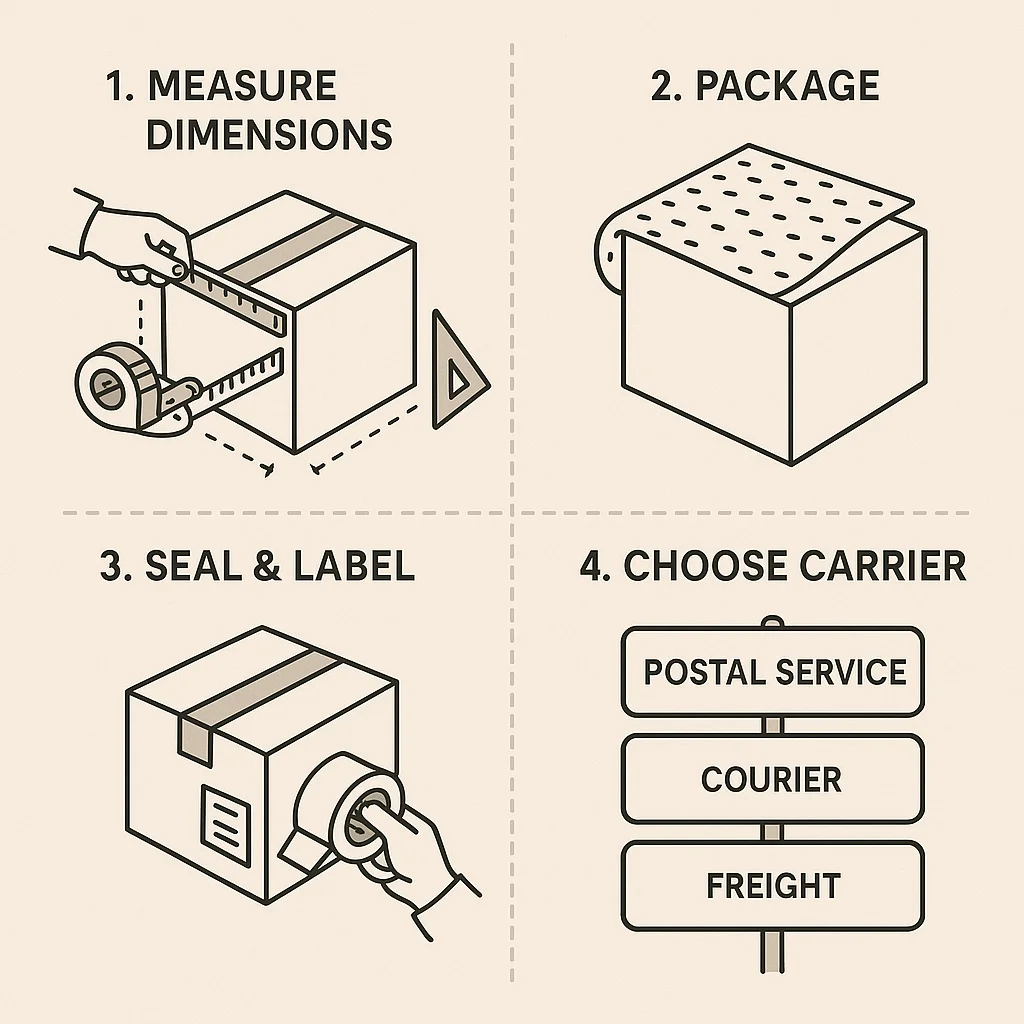Shipping large boxes or oversized items can be particularly challenging due to size and weight restrictions, special handling requirements, and potentially higher costs. Whether you’re moving bulky personal items, sending a large gift, or shipping products for business, this guide explains everything you need to know-from choosing appropriate packaging to selecting the right carrier and reducing costs-so you can ship large boxes and items safely, securely, and affordably.
Key Takeaways
Main Recommendation: To ship a large box or oversized item efficiently, plan ahead by measuring and weighing your shipment, selecting sturdy packaging or professional crating, comparing carrier dimensional and weight rates, and insuring valuables.
1. Understanding Size and Weight Restrictions
1.1 Dimensional Weight vs. Actual Weight
- Actual Weight: The scale-measured weight of your package in pounds or kilograms.
- Dimensional (DIM) Weight: A calculation based on package volume. Carriers use this when shipments are large but light to reflect the space taken in transit.
- Formula: (Length × Width × Height) ÷ DIM divisor (e.g., 166 for inches in FedEx/UPS domestic).
- Billable Weight: The higher of actual weight or dimensional weight determines the shipping cost.
1.2 Carrier Size Limits
- USPS: Maximum combined length and girth (2 × thickness + width + height) of 108 inches for retail Ground Advantage packages; longer parcels go via Retail Ground oversized (up to 130 inches).
- UPS & FedEx: Maximum length of 108 inches and maximum length plus girth of 165 inches for standard service; up to 150 pounds maximum weight.
- Freight Carriers: For extremely large or heavy items (>150 lbs or >165 inches), LTL (Less-Than-Truckload) freight shipping is required.
2. Preparing Your Large Box Shipment
2.1 Selecting the Right Packaging
- Heavy-Duty Corrugated Boxes: Double-wall or triple-wall boxes for added strength.
- Made-to-Measure Boxes and Crates: Custom crates (wooden or plastic) for awkwardly shaped items. Crating services from packing professionals ensure stability and stacking strength.
- Alternative to Boxes: For irregularly shaped large items, use padded envelopes (for flat items), shrink wrap with cardboard corner protectors, or soft packaging like moving blankets and stretch film.
2.2 Measuring and Weighing Accurately
- Use a tape measure for exterior dimensions.
- Measure length, width, height to the nearest inch or centimeter.
- Weigh on a reliable scale; if unavailable, borrow at a shipping center.
- Calculate dimensional weight: $ DIM Weight (lbs) = $
2.3 Packing Materials and Protection
- Interior Cushioning: Bubble wrap, foam inserts, air pillows, crumpled kraft paper.
- Edge and Corner Protection: Cardboard edge guards, foam corner protectors to absorb impacts.
- Void Fill: Ensure no internal movement by filling empty spaces.
- Sealing: Use heavy-duty packing tape (3” wide, pressure-sensitive) in H-taping method (three strips on top and bottom).
2.4 Labeling and Documentation
- Print clear shipping labels with sender and recipient details.
- Affix labels on the largest, flattest side.
- Cover labels with clear packing tape or label pouches for weather protection.
- Include a duplicate label inside the box in case the exterior label is damaged.
3. Choosing the Right Shipping Service
3.1 Comparison of Major Carriers
| Carrier | Service Type | Speed | Pricing Basis | Oversize Limitations |
|---|---|---|---|---|
| USPS | Retail Ground | 2–9 days | Weight, zone | Up to 130″ length+girth |
| UPS | Ground | 1–5 days | Billable weight | Up to 108″ length, 165″ length+girth, 150 lbs |
| FedEx | Ground/Home Delivery | 2–5 days | Billable weight | Up to 108″ length, 165″ length+girth, 150 lbs |
| LTL Freight | Standard | 3–7 days+ | Weight + class (density, value) | Very large/heavy; >150 lbs or >165″ |
3.2 When to Use LTL Freight
- Shipments weighing over 150 lbs or exceeding standard size limits.
- Palletized or crated items measured in cubic feet or pallet count.
- Requires freight class determination (1–500) based on density, stowability, fragility, and liability.
- Offers tailgate delivery, liftgate service, and residential delivery options.
3.3 Specialized and White-Glove Services
- Bulky, fragile, or high-value items (furniture, art, machinery).
- Professional packing, inside delivery, installation, debris removal.
- Higher cost but minimizes damage risk.
4. Shipping a Large Item Without a Box
4.1 Wrapping Techniques
- Shrink Wrap: Securely wrap the item, possibly on a wooden skid or pallet.
- Moving Blankets and Stretch Film: Protect surfaces and secure padding.
- Strapping: Use polyester strapping to hold blankets and film in place.
4.2 Palletizing Your Item
- Place item on a sturdy pallet sized appropriately.
- Bolt or screw item to pallet if possible.
- Use edge protection, and wrap entire pallet with stretch film.
- Attach a clear shipping label pouch to the pallet.
4.3 Crating Services
- For very large or awkward items (sculptures, equipment), professional crating provides a custom wooden or plastic crate.
- Crates allow forklift access, protect against environmental exposure, and can be sealed for security.
5. Cost-Saving Strategies
5.1 Optimizing Package Size
- Use the smallest possible box that safely fits the item plus cushioning.
- Reduce dimensional weight costs by minimizing empty volume.
5.2 Consolidation and Freight Aggregators
- Parcel Consolidators: Piggyback small shipments with bulk parcel services for discounts.
- Freight Brokers and Platforms: Compare multiple LTL quotes; leverage capacity to reduce cost.
5.3 Negotiating Carrier Rates
- Business Accounts: Negotiate volume discounts if you regularly ship in bulk.
- Contract Pricing: Lock in rates with carriers for committed shipment volumes.
5.4 Seasonal and Promotional Discounts
- Watch for carrier promotions (e.g., FedEx “More Savings” days).
- Plan shipments ahead of peak holiday seasons to avoid surcharges.
6. Insurance and Liability Coverage
6.1 Declared Value vs. Insurance
- Declared Value: Carriers’ maximum liability, typically limited to $100 per package unless increased.
- Third-Party Insurance: For high-value items, purchase separate insurance that covers full replacement value with fewer exclusions.
6.2 Filing Claims
- Document item condition with photographs before packing.
- Retain all packaging materials and paperwork.
- File claims promptly-USPS (60 days), FedEx/UPS (9 months).
7. Tracking and Delivery Confirmation
- Tracking Numbers: Provided by carrier; share with receiver.
- Delivery Options: Signature required, adult signature, delivery to neighbor.
- Notifications: Email or SMS updates for progress and delivery window.
8. International Shipping Considerations
- Customs Forms: Commercial invoice, NAFTA certificates if applicable.
- Duties and Taxes: Determine who pays (DDP vs. DDU).
- Restricted Items: Verify prohibited or restricted goods lists for origin and destination.
- Transit Times: Longer and less predictable; consider express services for time-sensitive shipments.
9. Step-by-Step Checklist
- Measure & Weigh: Determine actual and dimensional weight.
- Select Packaging: Choose box, crate, or pallet solution.
- Pack & Protect: Cushion interior, reinforce edges, seal securely.
- Label & Documentation: Affix labels, include paperwork.
- Choose Carrier & Service: Compare rates, transit times, weight/size limits.
- Book & Schedule Pickup: Drop off at carrier facility or arrange pickup.
- Insure & Track: Purchase coverage, monitor shipment status.
- Delivery & Inspection: Verify delivery, inspect item, and file claims if needed.
10. Common Pitfalls and How to Avoid Them
- Underestimating DIM Weight: Always calculate to prevent unexpected charges.
- Insufficient Cushioning: Use proper padding to avoid damage.
- Incorrect Carrier Selection: Don’t use parcel carriers for oversized freight.
- Missing Documentation: Label pouches and paperwork prevent customs delays.
- Overlooking Insurance: High-value items require coverage beyond basic liability.
Conclusion
Shipping large boxes or oversized items demands careful planning, from selecting the right packaging materials and accurately measuring dimensions to choosing the most suitable carrier service and insuring your shipment. By following best practices-optimizing package size, comparing rates, using professional crating when needed, and securing proper liability coverage-you can minimize costs and safeguard your items throughout the shipping journey. Proper execution of each step in this guide ensures your large shipments arrive on time, intact, and within budget.



Leave a Reply